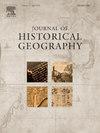在制图和地图之间:Hochstetter和Petermann的新西兰地图集(1863)制作中的跨地域知识
IF 1.1
2区 历史学
Q2 GEOGRAPHY
引用次数: 0
摘要
本文考察了维也纳地质学家Ferdinand von Hochstetter(1829-1884)和哥达制图师August Petermann(1822-1878)制作的第一张新西兰地图集。它为地图知识从实地到印刷的生产、交换和转化提供了新颖的见解。地质学-地形学家阿特拉斯·冯·纽-西兰(1863)在19世纪后期塑造新西兰地理想象方面发挥了重要作用,但它的起源在很大程度上仍然未知。通过研究以前未开发的档案资源,如通信、现场笔记和草图,本文分析了空间信息如何在不同的参与者和地点之间长距离传播。它追溯了这种“跨地方”的知识,从Hochstetter在奥地利护卫舰SMS Novara环球航行(1857-1859)期间在新西兰的田野工作,到Petermann在Gotha的Justus Perthes出版社的地图可视化。特别注意关键人物和机构之间的谈判,努力建立权威和信誉。他们对欧洲内外经常被边缘化的参与者的依赖,突显了影响地图绘制过程的权力-知识动态。本文章由计算机程序翻译,如有差异,请以英文原文为准。
Between mapping and maps: Translocal knowledge in the making of Hochstetter and Petermann's Atlas of New Zealand (1863)
This article examines the making of the first atlas of New Zealand, by the Viennese geologist Ferdinand von Hochstetter (1829–1884) and the Gotha cartographer August Petermann (1822–1878). It offers novel insights into the production, exchange, and transformation of map knowledge from the field to the printing press. The Geologisch-Topographischer Atlas von Neu-Seeland (1863) was instrumental in shaping the geographical imagination of New Zealand in the late nineteenth century, yet its origins have largely remained unknown. By studying previously untapped archival sources such as correspondence, field notes, and sketch maps, this article analyses how spatial information circulated over long distances between diverse actors and sites. It traces this ‘translocal’ knowledge from Hochstetter's fieldwork in New Zealand during the Austrian frigate SMS Novara's circumnavigation (1857–1859) to the cartographic visualisation under Petermann at the publishing house Justus Perthes in Gotha. Special attention is given to the negotiations among key figures and institutions in their efforts to establish authority and credibility. Their reliance on often marginalised actors, both within and beyond Europe, highlights the power–knowledge dynamics that influenced the mapmaking process.
求助全文
通过发布文献求助,成功后即可免费获取论文全文。
去求助
来源期刊

Journal of Historical Geography
Multiple-
CiteScore
1.50
自引率
10.00%
发文量
53
期刊介绍:
A well-established international quarterly, the Journal of Historical Geography publishes articles on all aspects of historical geography and cognate fields, including environmental history. As well as publishing original research papers of interest to a wide international and interdisciplinary readership, the journal encourages lively discussion of methodological and conceptual issues and debates over new challenges facing researchers in the field. Each issue includes a substantial book review section.
 求助内容:
求助内容: 应助结果提醒方式:
应助结果提醒方式:


